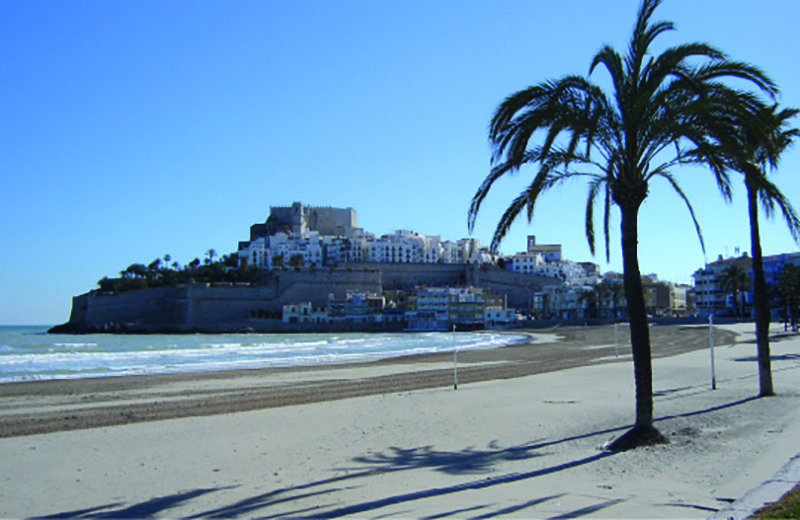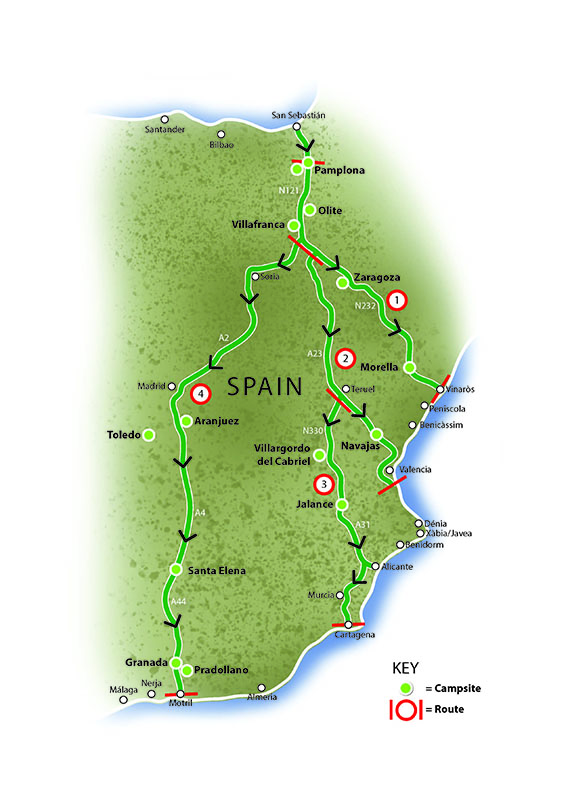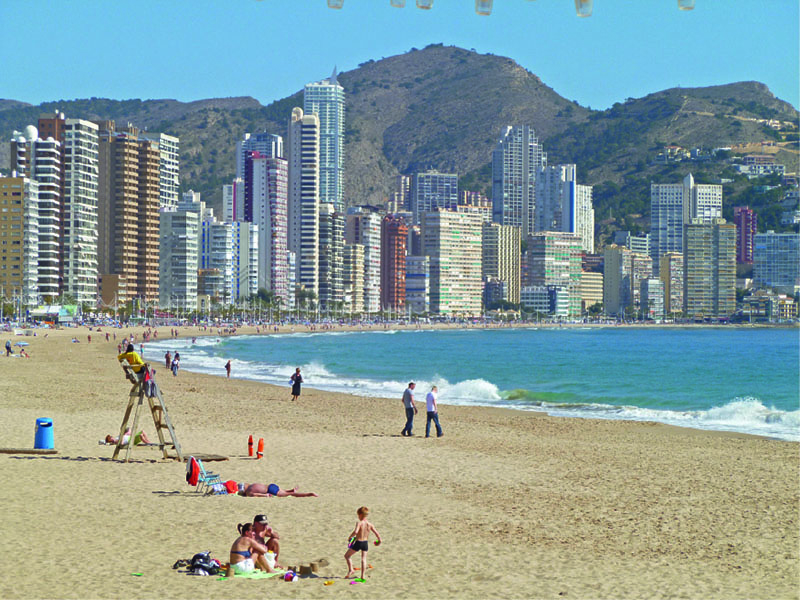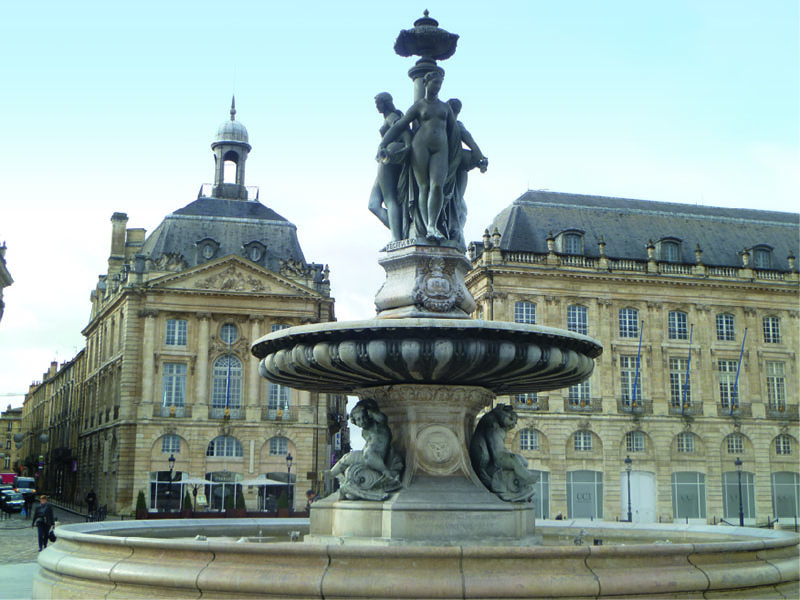Tailor-made motorhome routes to the Spanish costas
Forget the headache of planning, as the experts at MMM Magazine - Britain's best-selling motorhome magazine have done all the hard work for you and created these useful route plans.
 The Long Road South
The Long Road South
We guide you along a winter route to the Spanish Costas
You may be surprised at how many of us travel to Spain for the winter, to enjoy warmer weather and cheaper food, all subsidised by huge savings on winter energy bills. To get there, broadly speaking you have three options
- Ferry to the north coast of Spain and drive south to your chosen Costa
- Short crossing to northern France, motorways to Perpignan, then the Spanish AP7 coastal motorway to your destination
- Short crossing but drive across country through France and Spain
If, like us, you don’t fancy the Bay of Biscay in winter, or paying to use expensive motorways then the third option is best. When off on a long winter stay, a few extra days driving are insignificant and part of the enjoyment is the journey itself. Over the years we've fine-tuned the route to avoid tolls, city centres, trucking routes and roads through endless villages with speed bumps and traffic lights.
Our route starts from Calais or Dunkirk, but can be joined from Dieppe or Cherbourg. Driving over the inland passes in winter is risky and very slow. For destinations around Valencia or beyond there is little mileage saving compared to the much safer and faster route along the Atlantic coast near Biarritz.
Across France to the Spanish border
_web.jpg)
Stage 1: Calais to Rouen
Leave the ferry terminal and follow the A16 free motorway for 24 miles to Boulogne. Exit at junction 29 and drop down a hill. If under 3,500kg go straight on, otherwise the inside lane swings right down to a bridge, after which you turn left returning back to the main road. In under a mile the road forks; to stay on a coastal aire follow the D940; otherwise the D901 via Montreuil is faster. Either way, the destination is Abbeville where, before the city, you take the free A28 motorway all the way to Rouen.
Stage 2: Rouen to Nonancourt
There’s no sensible bypass for busy Rouen; they add too many miles or progress is slow. Our route only involves one major junction and, outside rush hour, traffic should be reasonable. The motorway becomes dual carriageway and drops down through a tunnel. Stay in the inside lane and in just under a mile take the third exit signposted to Vernon. The slip road ends in traffic lights, get in the centre lane to turn left across a dual carriageway. You are now in the inside lane for the next set of lights, so bear right onto the D6015 still signed Vernon. The Seine appears on the right. Continue to Pont-de-l’Arche, cross the river and stay on the D6015 for 4 miles to a roundabout. Go straight on and in 500 yards take the slip road towards motorways and Evreux. Cross the A13 and continue onto the free A154 motorway which becomes a fast dual carriageway past Evreux to Nonancourt where you meet the N12.
Stage 3: Nonancourt to Poitiers
Approaching the N12 the map will suggest turning left past Dreux to meet the N10 (a busy slow trucking route through Tours). So, turn right on the N12 to Alençon and enjoy mainly dual carriageway for 34 miles to Mortagne-au-Perche. Don’t enter the town, but continue on the N12 for 3 miles and take the second exit. Turn back under the main road, across the roundabout and at the next roundabout take the D401. Join the D938 south past Belleme and then the D301 past Bonnétable towards Le Mans. Just before Le Mans as you leave Savigne-l’Eveque turn left to the A11/A28 motorway junction. Continue straight on to seamlessly join the southern bypass and in 7½ miles, turn south, still the D323, past La Flèche and then turn to Baugé to Saumur. Cross the Loire and follow the fast D347 past Montreuil-Bellay and Loudun all the way to Poitiers.
Stage 4: Poitiers to Bayonne
Join the Poitiers ring northwest of the city and leave in four miles onto the N10. From here to Bayonne it’s fast dual carriageway with only Bordeaux having heavy traffic. Other routes go too far inland and are slow, so stick with it. Join a free section of the A10 motorway towards the city.
To stay on the Bordeaux campsite follow airport signs going north anticlockwise, otherwise continue clockwise to the free A63 motorway. In 15 miles you can take the A660 to Arcachon and coastal aires or continue for 13 miles when the free A63 suddenly changes back to the N10. This stretch towards Bayonne is now toll and difficult to avoid unless you go out to the coast. At the bottom of the N10 continue on the A63 toll motorway or take the D810 towards Bayonne, Biarritz and the Spanish border.
There are many coastal aires south of Bordeaux and in fine weather we advise a few nights stop. However in strong winds, remember it’s a forested area on light sandy soil, so parking under trees may be ill advised.
Stage 5: Bayonne and into Spain
The D810 runs parallel with the A63 past Biarritz and St Jean de Luz to the French border town of Hendaye and Spanish Irun just across the river. The road is quite slow. After crossing the border turn south on the N121 a fast road wriggling through the mountain foothills to Pamplona.
In good weather there are two passes you could take. They are prettier than the coastal sprawl but narrower winding roads mean no mileage saving and a longer journey time. Just before Biarritz, take the D932 south to Cambo-les-Bains. Turn towards Ainhoa to cross the border, or continue to St-Jean-Pied-de-Port and cross the Ibaneta Pass. Either way you end up in Pamplona.
Across Spain to the Costas
Much of central Spain is above 1,000 metres, so wintry weather is not unusual. You can drive long distances on good dual carriageways, called autovias. Traffic is generally light. However, inland campsites and suitable motorhome aires are few and far between.
Route 1 – to Costa del Azahar
Use this for Vinaròs, Peniscola and Benicasim.
From Pamplona drive south on the N121 for 50 miles to the N232 northwest of Tudela. Turn southeast on the A68 (long dual carriageway sections) for 50 miles to the Zaragoza ring road. Go south around the city and exit at junction 20 still on the A68. The road becomes the N232 for 125 miles past Alcañiz and Morella to Vinaròs.
Route 2 – to the Costa Blanca
Use this for Valencia, Denia, Javea and Benidorm
From Pamplona drive south on the N121 to Tudela as above. Turn southeast onto the A68 for 26 miles and, just after Mallen, turn right onto the N122 to Magallón, avoiding Zaragoza. In four miles, turn south on the A121 past La Almunia to Cariñena to join the A23, which is dual carriageway for 140 miles past Teruel all the way to Sagunto, north of Valencia. Join the free section of the A7 motorway around the city and take the N332 coast road for the popular resorts.
Route 3 – to the Gulf of Mazarron
This is ideal for Alicante, Torrevieja, Cartagena and Mazarron, taking a prettier cross country route to avoid Valencia and slow coast roads.
Follow Route 2 as far as Teruel. Take the N330 for 125 miles past Utiel to Almansa and join the A31 autovia into Alicante. For Cartagena, before Alicante, join the A7 past Elche to Murcia, then south on the A30 to the coast. Confusingly, also south of Elche, the AP7 motorway runs to the coast south of Torrevieja. This is free in parts at time of writing.
Route 4 - to the Costa del Sol
For Madrid, Granada and coastal resorts between Almeria and Marbella.
From Pamplona drive south on the N121 for 50 miles to the N232 northwest of Tudela. Go straight on at the N113 for 22 miles to the N122 which runs west to Soria and follow the ring to the north to pick up the A15 south past Almazán to Medinaceli. Join the A2 west all the way to the Madrid ring. Turn south and, in 17 miles, exit onto the A4 for 160 miles past Valdepeñas to Bailén. Turn south again for another 118 miles, on the A44, past Jaén and Granada to the coast at Motril.
Return Route
From mid-March onwards some Pyrenees passes will be open and you could consider a scenic mountain route back.
Try the magnificent Portalet Pass; the Zaragoza campsite or tourist office can advise if it’s open. Take the A23 north past Huesca, then the N330 over the Monrepos pass to Sabinanigo. Turn onto the A136 towards Biescas and the pass. There’s a good site, east of Biescas at Gavin, open all year. The top reaches 1,796m before descending to Laruns and Pau.
WHERE TO STAY
France has a big network of motorhome aires available all year. Most below have paved parking suitable for poor weather and are close to villages or towns for shopping and restaurants. Campsites listed are those we have used; others near the route can be found in the Caravan Club's Europe Guide but we cannot advise low season suitability. If you prefer campsites your route and driving time will be dictated by the few that remain open through the winter. Prices are a guide only.
Across France
Boulogne – Aire (N50 44 44 E1 35 53)
Large paved/gravel area by D940 north of town. Popular. €5 (£4.33) if collector calls. Water €3 (£2.60). Leave A16 at junction 32
Le Touquet – Aire (N50 32 10 E1 35 33)
Flat asphalt at marina, 40 bays. Ticket machine €13 (£11.27), may be disabled in winter. 1½ miles to town
Berck-sur-Mer – Aire (N50 23 48 E1 35 50)
Flat gravel, 75 bays, at Base Nautique. Free in winter. Popular with French
Forges-les-Eaux – Aire (N49 36 22 E1 32 33)
Flat asphalt, 30 ’vans. Free in winter but water and electricity is off. 11 miles south of A28, junction 10. Recommended
Pont-de-l’Arche – Aire (N49 18 21 E1 9 27)
Four bays and adjacent car park by river. Free but water is €2.50 (£2.17) using credit card. Left at traffic lights after bridge, left again along river
Brezolles – Aire (N48 41 26 E1 4 10)
Flat gravel/grass for 10 ’vans. Muddy parts if wet. Free. 9 miles SW of Nonancourt
St-Maurice-les-Charency – municipal site (N48 38 46 E0 45 16)
Small, flat, grass site. €12 (£10.40) w/o elec. Open all year, possibly muddy. By N12
Soligny-la-Trappe – Aire (N48 37 0 E0 32 38)
Flat gravel, 10 ’vans. Free. Tokens for water and electric. Six miles north of Mortagne-au-Perche
La Suze-sur-Sarthe – Aire (N47 53 20 E0 1 51)
Flat gravel, 20 ’vans, by river, muddy areas if wet. €5 (£4.33) including electric. From Le Mans ring don’t take D323, continue to D23
Saumur – Ille D’Offard campsite (N47 15 36 W0 3 53)
Grass/hardstanding, some low trees. 15min walk to town. Open mid-March to end-October. €17 (£14.74) with ACSI
Angliers – Aire (N46 57 36 E0 6 18)
Free parking, seven flat asphalt hedged bays at rural tourist centre. Water off. No shops but direct access from N147
Vivonne – Aire (N46 25 34 E0 15 47)
Six flat asphalt bays behind tourist office. Free. Water €2 (£1.73). Just off N10
Nersac – Aire (N45 37 34 E0 3 0)
Seven flat asphalt bays next to police station. Free and elec often on. Tight for vans over 8m. Just off N10 SW of Angouleme. Recommended
Bordeaux –Village du Lac campsite (N44 53 52 W-0 34 58)
Flat site with hardstanding. Open all year. €24 (£20.80). Bus/tram to city. Exit north ring, junction 5
Sanquinet – Aire (N44 18 38 W1 5 28)
15 flat gravel pitches, some between trees. Free in winter but water off. On A660 towards Arcachon, exit junction 1 to D216
Mimizan Plage – Aire (N44 12 18 W1 17 49)
Flat asphalt, 70 ’vans. Barrier control €8 (6.93) including water and elec via credit card. Recommended
Capbreton – Aire (N43 38 8 W1 26 48)
Spacious flat asphalt, 50 ’vans. Free in winter – no water or elec. 12 miles north of Bayonne
Anglet – Aire (N43 30 25 W1 32 1)
Sheltered asphalt parking, 50 ’vans. Levellers needed. Free in winter, water on but no elec.
Biarritz – Aire (N43 27 56 W1 34 18)
Slight slope, asphalt, 40 ’vans. Usually free until March. Some elec. Long walk or bus to centre
Spain: Pamplona area
Pamplona – Ezcaba campsite (N42 51 22 W1 37 24)
Flat grass site. By N121 five miles north of city. Open all year. €19 (£16.47) with ACSI
Pamplona – Aire (N42 50 29 W1 39 58)
In NW suburb, Berriozar. Free paved parking, 20 ’vans, service station
Olite – Camping Ciudad de Olite (N42 28 51 W1 40 42)
A few firm grass touring pitches. Open all year. €23 (£19.94) inc elec. Remote. By NA115 west of town
Villafranca - Camping Bardenas (N42 15 48 W1 44 19)
Open all year. Good facilities. €19 (£16.47) with ACSI. Exit N121 west on NA128, then south on NA660
Spain: Route 1
Zaragoza – Camping Ciudad de Zaragoza (N41 38 15 W0 56 34)
Flat gravel pitches. Open all year. €18 (£15.60) w/o elec. 5 min walk to shops and bus to centre
Morella – Aire (N40 37 28 W0 5 32)
Flat gravel, free parking, 10 ’vans, by N232. View of old town 15min walk away. Recommended
Spain: Route 2
Navajas – Camping Altomira (N39 52 29 W0 30 37)
Steep but asphalt roads to flat gravel pitches. Open all year. €17 (£14.74) with ACSI. Good restaurant. Recommended
Spain: Route 3
Villargordo del Cabriel – Camping Kiko Park (N39 33 3 W1 28 28)
Open all year. Lovely but remote. €17 (£14.74) with ACSI. From Utiel A3 west exit junction 255
Jalance – Aire (N39 11 16 W1 4 33)
Paved free parking, 10 ’vans. Drive-over drain and water. By N330 south of town
Spain: Route 4
Aranjuez – Camping Arajuez (N40 2 32 W3 35 58)
Good site in lovely town. Open all year. €19 (£16.47) with ACSI. Visit Madrid by train. Worth a few days’ stop
Toledo – Camping El Greco (N39 51 52 W4 2 48)
Visit Spain’s former capital by bus. Gravel pitches. Open all year. €25 (£21.67) inc elec. From Aranjuez take N400
Santa Elena – Camping Despeñaperros (N38 20 36 W3 32 8)
Earth pitches may be muddy. Open all year. €17 (£14.74) with ACSI. Just off A4 35 miles south of Valdepeñas
Granada – Camping Reina Isabel (N37 7 28 W3 35 8)
Open all year. €19 (£16.47) with ACSI. Could be tight if over 8m. Frequent bus to city
Pradollano – Aire (N37 6 6 W3 23 48)
Ski resort at 2,380m, roads kept open. Flat asphalt parking. €15 (£13) inc water/elec. Wonderful views
Distances and travel times
Stage 1 Calais to Rouen 140 miles 3hrs
Stage 2 Rouen to Nonancourt 50 miles 1.2hrs
Stage 3 Nonancourt to Poitiers 204 miles 5hrs
Stage 4 Poitiers to Bayonne 258 miles 5hrs
Stage 5 Bayonne and into Spain 81 miles 2.3hrs
Total 733 miles 16.5hrs
Route 1 Pamplona to Vinaròs 257 miles 6hrs
Route 2 Pamplona to Valencia 292 miles 6hrs
Route 3 Pamplona to Alicante 373 miles 9hrs
Route 4 Pamplona to Motril 540 miles 12hrs
Our motorhome
Pilote G640 LR A-class on Fiat Ducato, with 2.3-litre 130bhp engine
The costs
Totals depend not only on fuel, but how many stops you make and where you stay. Figures based on the last trip in early 2016 are shown. Diesel worked out around £0.80/litre. I get over 30mpg on long easy runs and average 28.5mpg
Through France
Return channel crossing £116
Diesel £187
Aires x 9 (8 free) £3
TOTAL £306
Pamplona to Costas and return
Route 2 Route 3 Route 4 Route 5
Diesel £66 £75 £96 £138
Aires x 3 – free x 2 – free x 4 – free 2 - free
Campsites 0 x 2 - £28 0 x 5 - £76
TOTAL £66 £129 £96 £214
General tips
- Be flexible on departure date. Book the crossing at the last moment and get a flexible return
- Buy a copy of Camperstop Europe, now available in English, or books listing aires in France and Spain from Vicarious Books
- Buy an ACSI low season discount card for lower winter campsite prices
- Do not stay overnight on motorway rest aires or lorry parks. Motorhome aires are entirely separate and usually close to village or town centres
- Use a credit card whenever possible, the exchange rate is better. If offered the option to pay in pounds or euros select euros. Pay the account by direct debit
- Check home insurance for unoccupied time, 30 days is common. Similarly check travel, vehicle and breakdown cover for overseas trip length limitations
- Huge home energy bill savings can be made. Eight weeks in Spain virtually halves our total annual bill and goes a very long way to offset the cost of the trip
Tips for France
- In winter, water supplies on aires may be shut off Carry enough water for a few days. Waste facilities including toilet cassette drains are always available
- If the aire has electric it’s worth connecting
- Keep a ticket machine fund, suggest €20, with 10, 20, 50cent and €1 coins. Payment by credit card, even for small amounts, is increasing
- Use supermarkets for ‘better value’ fuel. Many are changing to 24/7 pumps and closing manned booths. Fortunately, the updated pumps accept all popular credit cards and display English instructions
Tips for Spain
- Campsites on the Med are busy in winter. To tour without reservations arrive by midday for a better choice of available pitches
- Motorhome aires are not common but motorhome parks, small campsites just for ’vans, are springing up in the popular coastal areas
- Wild parking is much less tolerated. Large groups staying too long will be moved on by police
- There are plenty of fuel stations in built-up areas. Fill up before crossing the remote centre
This short guide was created by the team at MMM magazine, which has been Britain's best-selling motorhome magazine for the past 51 years! Every issue contains:
If you're interested in subscribing to MMM magazine, click here
If you enjoyed this article, you may also like to read:








Recent Updates
Engine management lights: all you need to know
What is the engine management light? What does it mean, and what do I have to do? ...
Motorhome air suspension: all you need to know
Motorhomes are heavy and the additional weight of equipment and height of the bodywork can increase the loads ...
Motorhome WiFi: how to get better motorhome internet
Staying connected on the move is more and more essential, so relying on campsite WiFi isn't an option – here ...
A class of their own - our guide to A-class motorhomes
Thinking of trading up to an A-class, or even going straight to the top of the motorhome tree? We guide you ...
Explore overseas on a motorhome dream tour
Enjoy exotic travel in a campervan or motorhome by hiring, swapping with someone else or exporting your ...
Motorhome water systems: everything you need to know
On-board water is an important part of every motorhome – here’s everything you need to know ...
Campervanning in Europe: what you need to know
Whether you're planning a leisurely drive through the French countryside, navigating bustling city streets in ...
Campervan security: all you need to know
With thefts on the increase, it’s important to know how to keep your campervan secure and prevent campervan ...
Campervan furniture: everything you need to know
Our campervan experts guide you through all the essentials for your campervan, including tables, chairs, ...
Campervan finance: how to fund your purchase
Here we look at the different types of campervan finance available, to help you decide what’s the best option ...
Other Articles
Britain’s best used motorhomes
Want a great motorhome without paying the premium for a new one? Here's a guide to the best you can get in the pre-owned market for each layout, ...
Which motorhome? Choosing the perfect motorhome for you
Choosing a motorhome or campervan is one of the biggest buying decisions you’ll ever make, so it's important ...
Campervan washroom essentials: stay fresh on the road
Our guide will take you through the campervan washroom essentials you'll need so you're well-prepared for ...
Dogs in campervans: all you need to know
Follow our advice and your dog will enjoy campervanning as much as you do ...
Electric campervans: all you need to know
Our guide will take you through everything you need to know about electric campervans and what the future ...
Motorhome electrics: a complete guide to your motorhome electrical set-up
Motorhome electrics can dramatically enhance the convenience and comfort of your vehicle – but they can be ...
Lighting for campervans: all you need to know
We guide you through all the lighting options available for you and your campervan, including interior ...
Electric bikes for motorhomes: our ultimate guide
Read our comprehensive guide to electric bikes for motorhome owners, helping you add electric power to your ...
Our guide to 'cheap' motorhomes in 2024
If you're on the hunt for an affordable new motorhome, this is the best place to start – we've rounded up a ...
Campervans in winter: all you need to know
Here's your guide to preparing your campervan for the colder months, whether you will be using it or putting ...